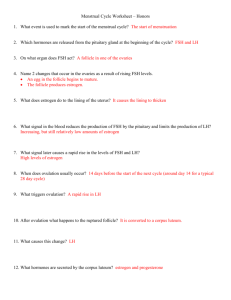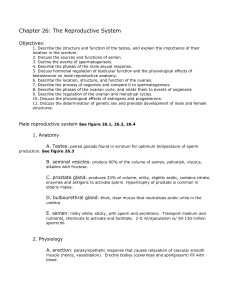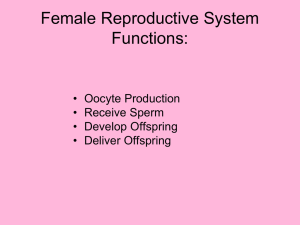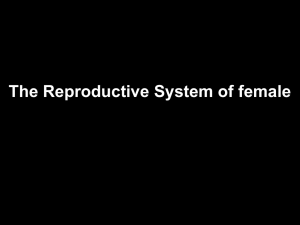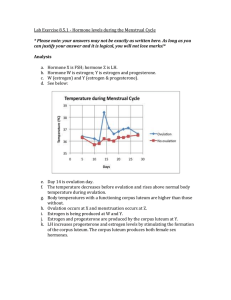The Female Reproductive System
advertisement
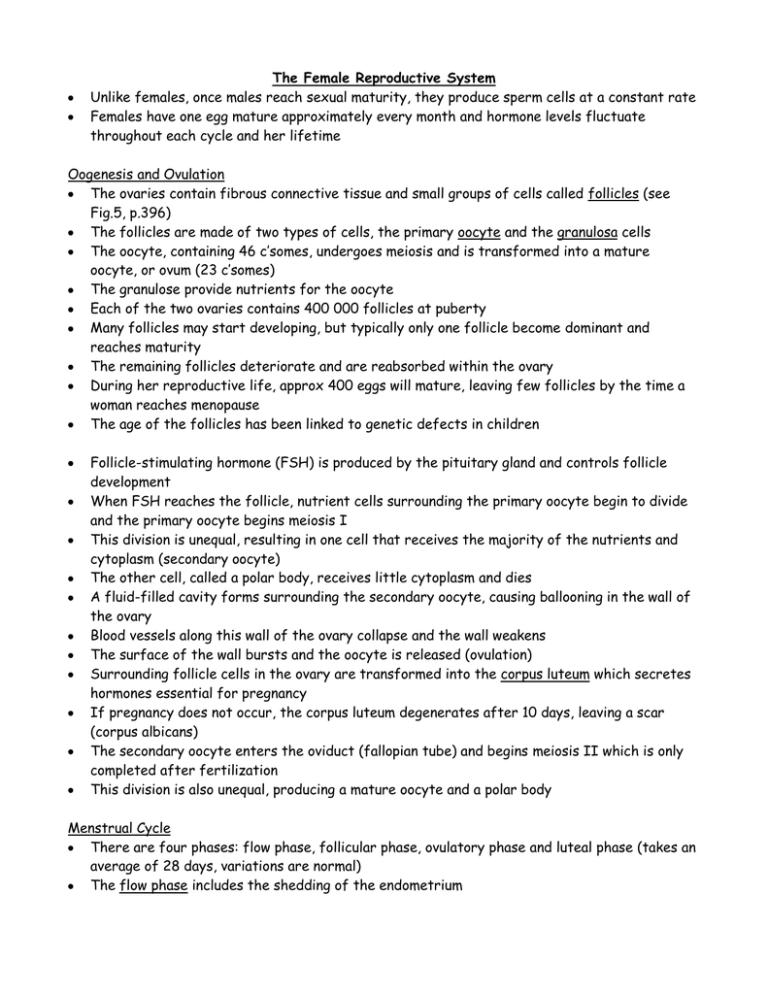
The Female Reproductive System Unlike females, once males reach sexual maturity, they produce sperm cells at a constant rate Females have one egg mature approximately every month and hormone levels fluctuate throughout each cycle and her lifetime Oogenesis and Ovulation The ovaries contain fibrous connective tissue and small groups of cells called follicles (see Fig.5, p.396) The follicles are made of two types of cells, the primary oocyte and the granulosa cells The oocyte, containing 46 c’somes, undergoes meiosis and is transformed into a mature oocyte, or ovum (23 c’somes) The granulose provide nutrients for the oocyte Each of the two ovaries contains 400 000 follicles at puberty Many follicles may start developing, but typically only one follicle become dominant and reaches maturity The remaining follicles deteriorate and are reabsorbed within the ovary During her reproductive life, approx 400 eggs will mature, leaving few follicles by the time a woman reaches menopause The age of the follicles has been linked to genetic defects in children Follicle-stimulating hormone (FSH) is produced by the pituitary gland and controls follicle development When FSH reaches the follicle, nutrient cells surrounding the primary oocyte begin to divide and the primary oocyte begins meiosis I This division is unequal, resulting in one cell that receives the majority of the nutrients and cytoplasm (secondary oocyte) The other cell, called a polar body, receives little cytoplasm and dies A fluid-filled cavity forms surrounding the secondary oocyte, causing ballooning in the wall of the ovary Blood vessels along this wall of the ovary collapse and the wall weakens The surface of the wall bursts and the oocyte is released (ovulation) Surrounding follicle cells in the ovary are transformed into the corpus luteum which secretes hormones essential for pregnancy If pregnancy does not occur, the corpus luteum degenerates after 10 days, leaving a scar (corpus albicans) The secondary oocyte enters the oviduct (fallopian tube) and begins meiosis II which is only completed after fertilization This division is also unequal, producing a mature oocyte and a polar body Menstrual Cycle There are four phases: flow phase, follicular phase, ovulatory phase and luteal phase (takes an average of 28 days, variations are normal) The flow phase includes the shedding of the endometrium Because this phase is externally evident, the first day of the flow phase is marked as the first day of the cycle The follicular phase is when the follicle develops within the ovary During this phase, estrogen is secreted During ovulation the egg bursts from the ovary and follicular cells differentiate into the corpus luteum This marks the beginning of the luteal phase Estrogen levels decline when the oocyte leaves the ovary, but rise when the corpus luteum forms The corpus luteum also secretes progesterone which stimulates the endometrium and prepares the uterus for an embryo It also inhibits futher ovulation and prevents uterine contractions If fertilization of the ovum does not occur, estrogen and progesterone decrease, causing weak uterine contractions, making the endometrium pull away from the uterine wall so it can be shed (see Table 3, p.398) Hormonal Control of the Female Reproductive System The hypothalamus-pituitary complex regulates the production of estrogen and progesterone (the ovarian hormones) (see Fig.7, p. 398) Gonadotropin releasing hormone (GnRH) is secreted by the hypothalamus and signals the anterior pituitary to release follicle-stimulating hormone (FSH) and lutenizing hormone (LH) During the follicular phase of the menstrual cycle, the blood carries FSH to the ovary, where follicle development is stimulated The follicles in the ovary release estrogen, which initiates the development of the endometrium As estrogen levels rise, a negative feedback message is sent to the pituitary gland to turn off secretions of FSH The rising estrogen also signals the pituitary to release LH, signalling ovulation and the production of the corpus luteum Cells of the corpus luteum release estrogen and progesterone, causing the build up of the endometrium High levels of estrogen and progesterone inhibit the release of FSH and LH (preventing further ovulation) Without FSH and LH, the corpus luteum breaks down, stops releasing estrogene and progesterone and triggers menstruation A summary of the female reproductive hormones is found in table 4, p. 399 Homework p.399 # 4-12, 14

